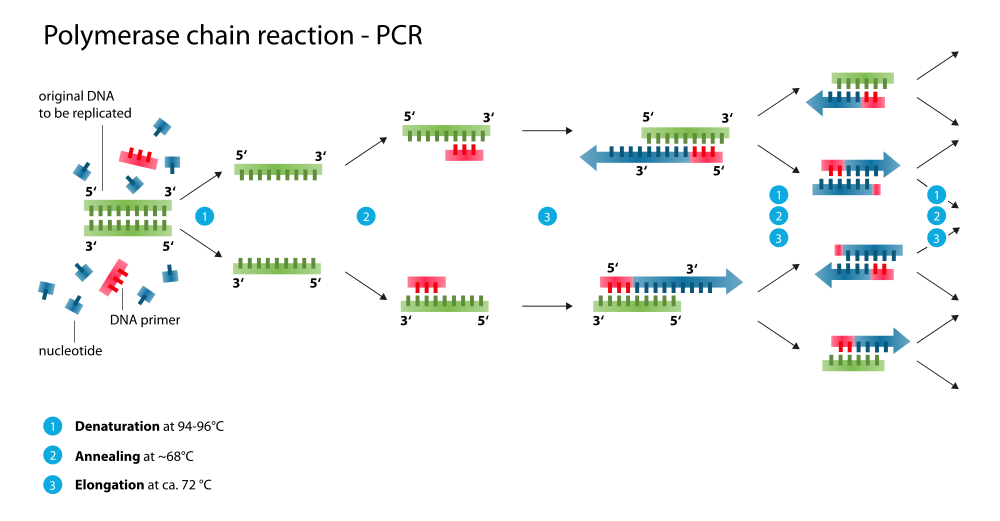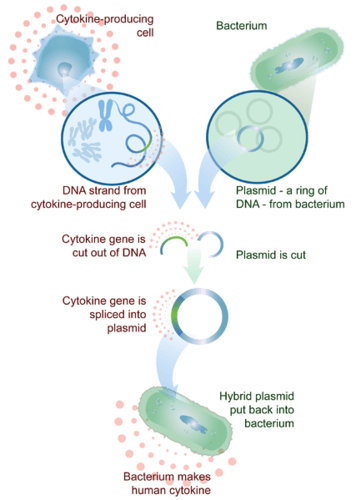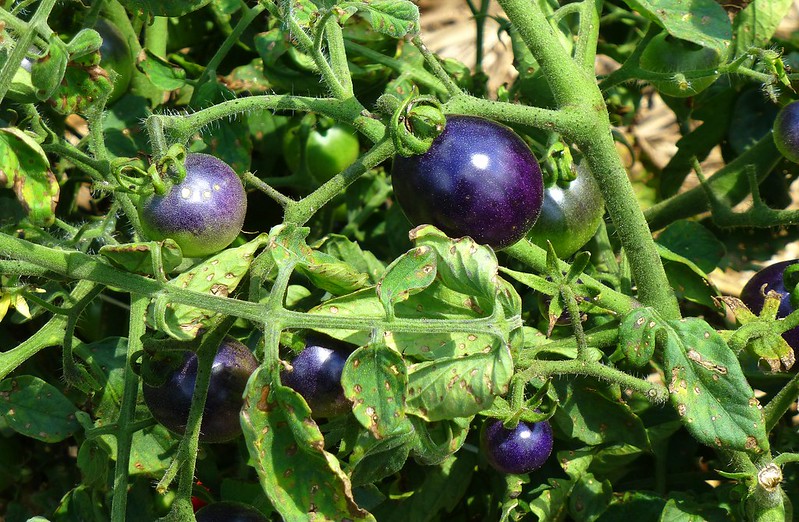56 5.16 Genetic Engineering
Created by: CK-12/Adapted by Christine Miller
Figure 5.16.1 Potato plants: One genetically engineered and healthy (left), and one infected with bacterial ring rot (right).
Please Pass the Potatoes
You might want to pass on the potato plants on the right in Figure 5.16.1. They are infected with a virus, which is quickly killing them. The potato plants on the left are healthy and productive. Why aren’t they infected with the same virus? The plants on the left have been genetically engineered to make them resistant to the virus.
What Is Genetic Engineering?
Genetic engineering is the use of technology to change the genetic makeup of living things for human purposes. Generally, the goal of genetic engineering is to modify organisms so they are more useful to humans. Genetic engineering, for example, may be used to create crops that yield more food or resist insect pests or viruses, such as the virus-resistant potatoes pictured (left) in Figure 5.16.1 . Research is also underway to use genetic engineering to cure human genetic disorders with gene therapy.
Genetic Engineering Methods
Genetic engineering uses a variety of techniques to achieve its aims. Two commonly used techniques are gene cloning and the polymerase chain reaction.
Gene Cloning
Gene cloning is the process of isolating and making copies of a gene. This is useful for many purposes. For example, gene cloning might be used to isolate and make copies of a normal gene for gene therapy. Gene cloning involves four steps: isolation, ligation, transformation, and selection.
- In the isolation step, an enzyme is used to break DNA at a specific base sequence. This is done to isolate a gene.
- During ligation, the enzyme DNA ligase combines the isolated gene with plasmid DNA from bacteria. (Plasmid DNA is circular DNA that is not part of a chromosome and can replicate independently). The DNA that results is called recombinant DNA.
- In transformation, the recombinant DNA is inserted into a living cell, usually a bacterial cell.
- Selection involves growing transformed bacteria to make sure they have the recombinant DNA. This is a necessary step because transformation is not always successful. Only bacteria that contain the recombinant DNA are selected for further use.
Polymerase Chain Reaction
The polymerase chain reaction (PCR) makes many copies of a gene or other DNA segment. This might be done in order to make large quantities of a gene for genetic testing. PCR involves three steps: denaturing, annealing, and extension. The three steps are illustrated in Figure 5.16.2. They are repeated many times in a cycle to make large quantities of the gene.
- Denaturing involves heating DNA to break the bonds holding together the two DNA strands, yielding two single strands of DNA.
- Annealing involves cooling the single strands of DNA and mixing them with short DNA segments called primers. Primers have base sequences that are complementary to segments of the single DNA strands. As a result, bonds form between the DNA strands and primers.
- Extension [or Elongation] occurs when an enzyme (Taq polymerase or Taq DNA polymerase) adds nucleotides to the primers. This produces new DNA molecules, each incorporating one of the original DNA strands.

Uses of Genetic Engineering
Methods of genetic engineering can be used for many practical purposes. They are used widely in both medicine and agriculture.
Applications in Medicine

In addition to gene therapy for genetic disorders, genetic engineering can be used to transform bacteria so they are able to make human proteins (see Figure 5.16.3). Proteins made by the bacteria are injected into people who cannot produce them because of mutations.
Insulin was the first human protein to be produced in this way. Insulin helps cells take up glucose from the blood. People with type 1 diabetes have a mutation in the gene that normally codes for insulin. Without insulin, their blood glucose rises to harmfully high levels. At present, the only treatment for type 1 diabetes is the injection of insulin from outside sources. Until recently, there was no known way to make human insulin outside the human body. The problem was solved by gene cloning. The human insulin gene was cloned and used to transform bacterial cells, which could then produce large quantities of human insulin.
Applications in Agriculture
Genetic engineering has been used to create transgenic crops. Transgenic crops are genetically modified with new genes that code for traits useful to humans.
Transgenic crops have been created with a variety of different traits. They can yield more food, taste better, survive drought, tolerate salty soil, and resist insect pests, among other things. Scientists have even created a transgenic purple tomato (Figure 5.16.4) that contains high levels of cancer-fighting compounds called antioxidants.

Ethical, Legal, and Social Issues
The use of genetic engineering has raised a number of ethical, legal, and social issues. Here are just a few:
- Who owns genetically modified organisms (such as bacteria)? Can such organisms be patented like inventions?
- Are genetically modified foods safe to eat? Might they have harmful effects on the people who consume them?
- Are genetically engineered crops safe for the environment? Might they harm other organisms — or even entire ecosystems?
- Who controls a person’s genetic information? What safeguards ensure that the information is kept private?
- How far should we go to ensure that children are free of mutations?
This example shows how complex such issues may be:

A strain of corn has been created with a gene that encodes a natural pesticide. On the positive side, the transgenic corn is not eaten by insects, so there is more corn for people to eat. The corn also doesn’t need to be sprayed with chemical pesticides, which can harm people and other living things. On the negative side, the transgenic corn has been shown to cross-pollinate nearby milkweed plants. Offspring of the cross-pollinated milkweed plants are now known to be toxic to monarch butterfly caterpillars that depend on them for food. Scientists are concerned that this may threaten the monarch species, as well as other species that normally eat monarchs.
As this example shows, the pros of genetic engineering may be obvious, but the cons may not be known until it is too late, and the damage has already been done. Unforeseen harm may be done to people, other species, and entire ecosystems. No doubt the ethical, legal, and social issues raised by genetic engineering will be debated for decades to come.
Feature: Reliable Sources
Genetically modified foods (or GM foods) are foods produced from genetically modified organisms. These are organisms that have had changes introduced into their DNA using methods of genetic engineering. Commercial sale of GM foods began in 1994, with a tomato that had delayed ripening. By 2015, three major crops grown in the U.S. were raised mainly from GM seeds, including field corn, soybeans, and cotton. Many other crops were also raised from GM seeds, ranging from a variety of vegetables to sugar beets. Other sources of GM foods in our diet include meats, eggs, and dairy products from animals that have eaten GM feed, as well as a plethora of food products that contain some form of soy or corn products, such as soybean oil, soybean flour, corn oil, corn starch, and corn syrup. A quick glance at the ingredients list of most processed foods shows that these products are added to many of the items in a typical American diet.
Most scientists think that GM foods are not necessarily any riskier to human health than conventional foods. Nonetheless, in many countries, including the U.S., GM foods are given more rigorous evaluations than conventional foods. For example, GM foods are assessed for toxicity, ability to cause allergic reactions, and stability of inserted genes. GM crops are also evaluated for possible environmental effects, such as outcrossing, which is the migration of genes from GM plants to conventional crops or wild plant species.
Despite the extra measures used to evaluate GM foods, there is a lot of public concern about them, including whether they are safe for human health, how they are labeled, and their environmental impacts. These concerns are based on a number of factors, such as the worrying belief that scientists are creating entirely new species, and a perceived lack of benefits to the consumer of GM foods. People may also doubt the validity of risk assessments, especially with regard to long-term effects. Lack of labeling of GM foods is also an issue because it denies consumers the choice of buying GM or conventional foods.
Find reliable online sources about GM foods. Look for information to answer the questions below. Make sure you evaluate the nature of the sources when you assess the reliability of the information they provide. Consider whether the sources may have a vested interest in one side of the issue or another. For example, major chemical companies might promote the use of seeds for crops that have been genetically engineered to be herbicide tolerant. Why? Because it boosts the use of the weed-killing chemical herbicides they produce and sell.
- In what ways are crops modified genetically? What traits are introduced, and what methods are used to introduce them?
- What are the main human safety questions about GM foods? How is the human safety of GM foods assessed?
- What are the main environmental concerns about GM crops? How is risk assessment for the environment performed?
- What are the major pros and cons of GM crops and foods? Who is most affected by these pros and cons? For example, for pros, do growers and marketeers receive most of the benefits, or do consumers also reap rewards?
5.16 Summary
- Genetic engineering is the use of technology to change the genetic makeup of living things for human purposes.
- Genetic engineering methods include gene cloning and the polymerase chain reaction. Gene cloning is the process of isolating and making copies of a DNA segment, such as a gene. The polymerase chain reaction makes many copies of a gene or other DNA segment.
- Genetic engineering can be used to transform bacteria so they are able to make human proteins, such as insulin. It can also be used to create transgenic crops, like crops that yield more food or resist insect pests.
- Genetic engineering has raised a number of ethical, legal, and social issues. For example, are genetically modified foods safe to eat? Who controls a person’s genetic information?
5.16 Review Questions
- Define genetic engineering
-
- What is recombinant DNA?
- Identify the steps of gene cloning.
- What is the purpose of the polymerase chain reaction?
- Make a flow chart outlining the steps involved in creating a transgenic crop.
- Explain how bacteria can be genetically engineered to produce a human protein.
- Identify an ethical, legal, or social issue raised bygenetic engineering. State your view on the issue, and develop a logical argument to support your view.
- Explain what primers are and what they do in PCR.
- The enzyme Taq polymerase was originally identified from bacteria that live in very hot environments, such as hotsprings. Why does this fact make Taq polymerase particularly useful in PCR reactions?
5.16 Explore More
What is Genetic Engineering?, Eco-Wise Videos, 2015.
Bringing biotechnology into the home: Cathal Garvey at TEDxDublin,
TEDx Talks, 2013.
Attributions
Figure 5.16.1
- Potato Plant by Lehava Maghar (Pikiwikisrael) on Wikimedia Commons via the PikiWiki – Israel free image collection project is used under a CC BY 2.5 (https://creativecommons.org/licenses/by/2.5/) license.
- Potato Plant Infected with Bacterial Ring Rot by William M. Brown Jr. on Wikimedia Commons via William M. Brown Jr., Bugwood.org via forestryimages.org is used under a CC BY 3.0 US (https://creativecommons.org/licenses/by/3.0/us/deed.en) license.
Figure 5.16.2
Polymerase_chain_reaction.svg by Enzoklop on Wikimedia Commons is used under a
CC BY-SA 3.0 (https://creativecommons.org/licenses/by-sa/3.0/deed.en) license.
Figure 5.16.3
Genetic Engineering in Medicine by CK-12 Foundation is used under a CC BY-NC 3.0 (https://creativecommons.org/licenses/by-nc/3.0/) license.
 ©CK-12 Foundation Licensed under
©CK-12 Foundation Licensed under ![]() • Terms of Use • Attribution
• Terms of Use • Attribution
Figure 5.16.4
Purple Tomato/Indigo Rose by F Delventhal on Flickr is used under a CC BY 2.0 (https://creativecommons.org/licenses/by/2.0/) license.
Figure 5.16.5
Monarch_Butterfly_and_Bumble_Bee_on_Swamp_Milkweed_(28960994212) by U.S. Fish and Wildlife Service on Wikimedia Commons is in the public domain (https://en.wikipedia.org/wiki/Public_domain).
References
Brainard, J/ CK-12 Foundation. (2016). Figure 4 Genetically engineering bacteria to produce a human protein. [digital image]. In CK-12 College Human Biology (Section 5.15) [online Flexbook]. CK12.org. https://www.ck12.org/book/ck-12-college-human-biology/section/5.15/
Eco-Wise Videos. (2015, March 28). What is genetic engineering? YouTube. https://www.youtube.com/watch?v=3IsQ92KiBwM&feature=youtu.be
TEDx Talks. (2013, October 22). Bringing biotechnology into the home: Cathal Garvey at TEDxDublin. YouTube. https://www.youtube.com/watch?v=g_ZswrLFSdo&feature=youtu.be
The use of technology to change the genetic makeup of living things for human purposes.
The process of isolating and making copies of a gene.
Biological molecules that lower amount the energy required for a reaction to occur.
Deoxyribonucleic acid - the molecule carrying genetic instructions for the development, functioning, growth and reproduction of all known organisms and many viruses.
A sequence of nucleotides in DNA or RNA that codes for a molecule that has a function.
An experimental technique that uses genes to treat or prevent disease.
Diseases, syndromes, or other abnormal conditions caused by mutations in one or more genes, or by chromosomal alterations.
Any member of a large group of unicellular microorganisms which have cell walls but lack organelles and an organized nucleus, including some which can cause disease.
The part of each hemisphere of the cerebrum that is involved in functions such as touch, reading, and arithmetic.
A hormone made by the pancreas that allows your body to use sugar (glucose) from carbohydrates in the food that you eat for energy or to store glucose for future use.
Plants used in agriculture, the DNA of which has been modified using genetic engineering methods. In most cases, the aim is to introduce a new trait to the plant which does not occur naturally in the species.
A method used widely in molecular biology to make millions to billions of copies of a specific DNA sample rapidly, allowing scientists to take a very small sample of DNA and amplify it to a large enough amount to study in detail.

